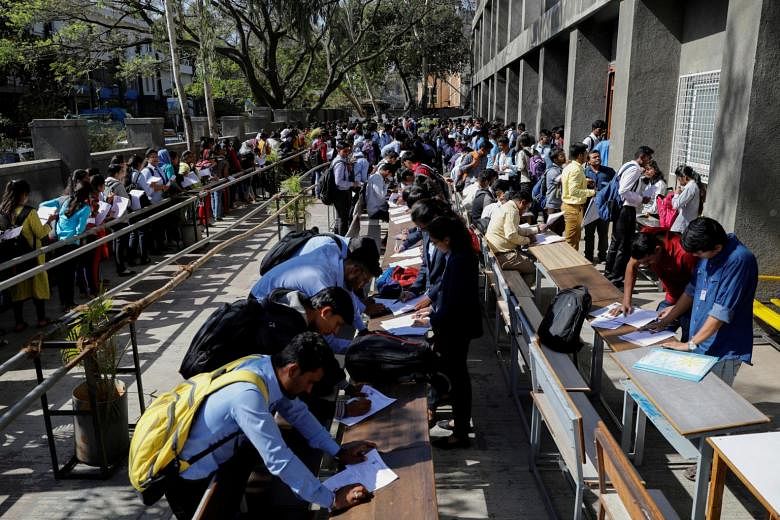NEW DELHI (REUTERS) - India's economy grew at its slowest pace in more than four years in the January-March period, falling behind China's pace for the first time in nearly two years and raising the prospect of fiscal stimulus and a rate cut.
Asia's third largest economy grew at a much slower-than-expected 5.8 per cent in the last quarter, compared with 6.4 per cent in China, government data showed on Friday (May 31).
The figures were released as Prime Minister Narendra Modi started his second term.
A Reuters poll of economists had forecast a growth rate of 6.3 per cent for the March quarter, compared with a 6.6 per cent rise in the October-December period in 2018.
Mr Devendra Kumar Pant, chief economist at India Ratings & Research in New Delhi, said there were signs of a further slowdown in the economy.
"The government has a very limited fiscal space. However, current economic conditions call for some stimulus," he said.
India's Finance Secretary, Subhash Chandra Garg, said the economy could grow "relatively slower" this quarter but would start turning around from the July-September quarter with favourable interest rates and an improvement in liquidity.
He said the last quarter was hurt by weak consumption demand and tepid private investment.
Finance ministry sources say Nirmala Sitharaman, the country's new finance minister, could cut taxes in her first full-year budget on July 5 to boost demand.
The Reserve Bank of India is also expected to reduce interest rates at its June 4-6 policy meeting.
On Friday, the Ministry of Statistics and Programme Implementation cut its growth estimate for the fiscal year that ended on March 31 to 6.8 per cent, the lowest in five years, from a previously projected 7 per cent.
Separate data released the same day showed India's unemployment rate rose to 6.1 per cent in the 2017/18 fiscal year, matching data earlier leaked to a newspaper that said it was the highest level in at least 45 years.
WEAKENING DEMAND
Several indicators - automobile sales, rail freight, petroleum product consumption, domestic air traffic and imports - indicate a slowdown in domestic consumption.
Private investment in India grew 7.2 per cent in the March quarter, down from 8.4 per cent in the previous quarter. Capital investment growth slowed to 3.6 per cent from 10.6 per cent, government data showed.
Government spending, however, rose 13.1 per cent in the March quarter from 6.5 per cent ahead of the April-May elections, widening the fiscal deficit in the last financial year.
The farm sector contracted 0.1 per cent in the March quarter compared with 2.7 per cent growth in the previous quarter, while manufacturing grew 3.1 per cent, slower than 6.7 per cent in the previous quarter.
Corporate earnings grew at a six-quarter low of 10.7 per cent during January-March period on weakening consumer sentiment and softening commodity prices, ICRA, the Indian arm of the ratings agency Moody's, said on Tuesday, citing a sample of more than 300 companies.
Nevertheless, many economists and officials expect the government to push long-pending reforms starting in the next parliamentary session beginning on June 17, after its landslide election victory.
"Big-bang" economic programmes in the first 100 days of Modi's second term could focus on privatisation of state assets and relaxation of labour and land rules for businesses, a top official at the government's main think-tank told Reuters.

